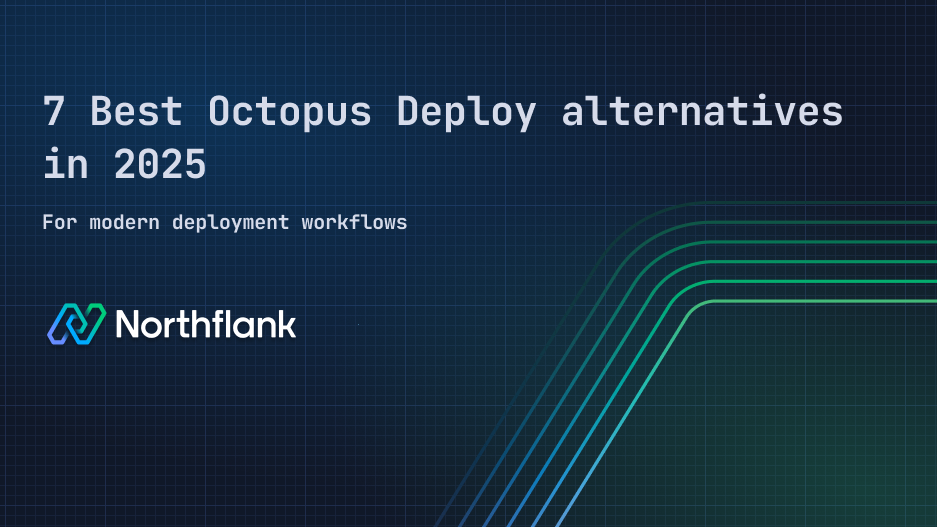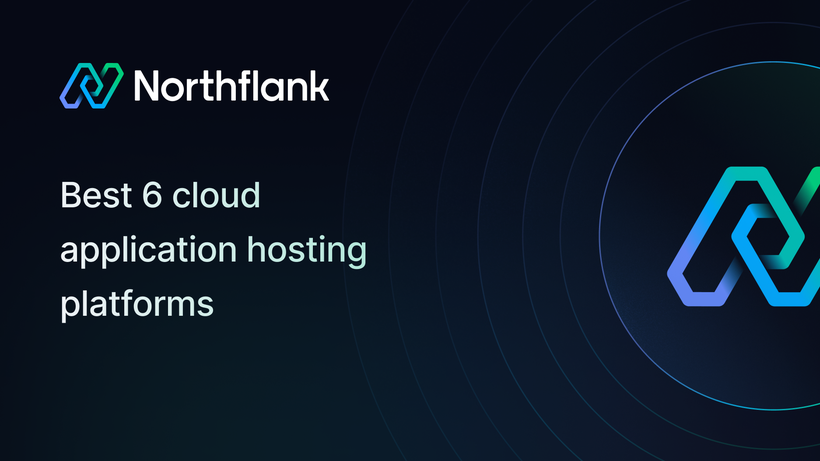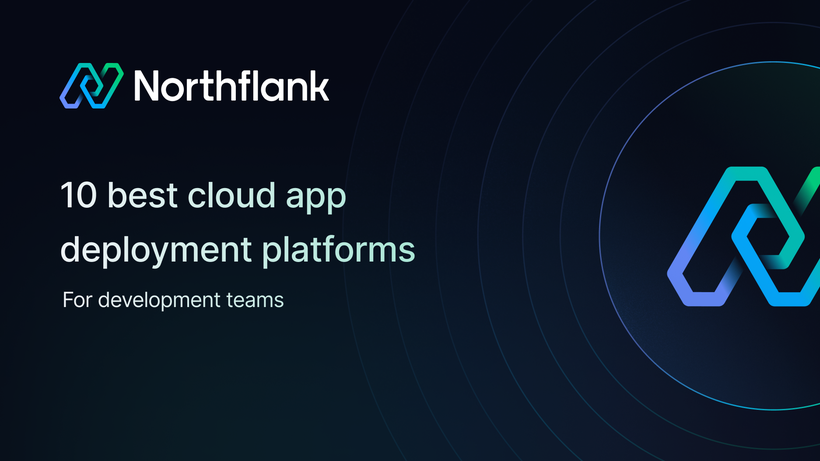

7 Best Octopus Deploy alternatives for modern deployment workflows (2025)
Are you looking for Octopus Deploy alternatives? This will help!
I know that for a long time, engineering teams have used Octopus Deploy to manage deployment pipelines and promote releases across environments. It’s well known for things like:
- It's visual UI
- Step-based deployment process
- Its ability to handle multi-environment delivery
The thing now is, our infrastructure practices continue to develop, and the tools we use need to keep up. You’ve likely noticed the shift toward GitOps, Kubernetes, and cloud-native workflows.
That’s why more developers and DevOps engineers are turning to tools that integrate better into their Git workflows, automate more of the release process, and support containers and microservices without being too complex.
Don’t get me wrong, Octopus Deploy still works. It’s just not always aligned with these new expectations.
In this article, I’ll walk you through 7 Octopus Deploy alternatives and help you find a solution that fits your needs.
In a hurry? Here's a quick breakdown of some of the best Octopus Deploy alternatives for 2025:
- Northflank – Built-in CI/CD, Git-based workflows, Kubernetes support, and BYOC.
- Harness – Enterprise CI/CD with governance, cost tracking, and automated rollbacks.
- Argo CD – GitOps-native tool for declarative delivery on Kubernetes.
- GitHub Actions – Integrated CI/CD for GitHub users, simple for basic deploys.
- Jenkins + Spinnaker – Classic combo for complex pipelines and multi-cloud deployments.
- Flux CD – Lightweight GitOps tool with Helm and Kustomize support.
- Azure DevOps Pipelines – Best for teams already using Microsoft tools.
Before we go into the nitty-gritty of things, if you’re in a hurry, the table below compares these 7 Octopus Deploy alternatives to help you find a solution quickly.
| Tool | CI/CD & GitOps support | Kubernetes support | BYOC (Bring Your Own Cloud) | Ideal for |
|---|---|---|---|---|
| Northflank | Built-in CI/CD with Git-based deployment flows | Native support with zero config required | Yes | Teams that want Git-native workflows, built-in observability, and easy K8s + container deploys |
| Harness | Enterprise pipelines, not GitOps-native | Extensive support via pipelines and integrations | No | Enterprises needing policy enforcement, cost control, and complex deployment strategies |
| Argo CD | No CI, GitOps-first, declarative model | Kubernetes-native, syncs state from Git | No | Teams doing GitOps for K8s using Helm, Kustomize, or raw YAML |
| GitHub Actions | Integrated CI/CD, partial GitOps via workflows | Works with K8s using external actions | No | Developers looking for simple CI/CD built into GitHub, ideal for small apps and microservices |
| Jenkins + Spinnaker | Jenkins for CI, Spinnaker for CD with Git triggers | Comprehensive K8s support with advanced rollout logic | No | Large orgs with legacy systems or multi-cloud deployment needs |
| Flux CD | No CI, GitOps-native, lightweight | Designed for Kubernetes and Helm support | No | Platform engineers or SREs managing declarative delivery from Git |
| Azure DevOps Pipelines | Full CI/CD with YAML pipelines, no native GitOps | Basic support with custom config needed | No | Teams already using Azure Boards, Repos, and other Microsoft DevOps tooling |
When comparing alternatives, it helps to think about your delivery approach, infrastructure stack, and team preferences. Here are some things you should look out for:
- Do you prefer Git-based workflows or a visual UI?
Octopus uses a drag-and-drop UI. Tools like Argo CD, Flux, and Northflank offer GitOps-style delivery where Git is the single source of truth.
- Are you deploying to Kubernetes, VMs, or a mix?
If your infrastructure is containerized or uses K8s, native support (like in Northflank, Argo, or Flux) makes deployments smoother.
- Do you need secret management, observability, and service integration?
Some tools integrate this out of the box. Others require connecting third-party services.
- Do you prefer hosted or self-managed solutions?
Tools like Jenkins and Spinnaker require hosting and maintenance. Platforms like Northflank or GitHub Actions take that burden off your hands.
- Do you need Bring Your Own Cloud (BYOC)?
Most platforms don't support it. Northflank allows teams to deploy into their own cloud while keeping things managed.
Now let’s go into the details of these alternatives to help you decide which you should go for or best suits your needs.
If your team builds containerized apps and you want to deploy them quickly without stitching together five different tools, Northflank gives you a unified workflow. It’s especially helpful for fast-moving product teams that want to spin up environments straight from Git without worrying about infrastructure setup.

Northflank is a fully managed deployment platform that combines CI/CD, service orchestration, and infrastructure management in one place. It’s designed to reduce operational overhead while giving developers full control over their services.
What you can do with Northflank:
- Automate builds and deployments directly from your Git repo
- Spin up preview environments for every pull request
- Run cron jobs, background workers, and standalone services
- Inject secrets and environment variables securely
- Use built-in observability with logs, metrics, and resource insights
- Deploy to Northflank-managed infrastructure or your own cloud (BYOC)
Ideal if you're looking for: An all-in-one platform with Git-based workflows, managed services, and BYOC (Bring Your Own Cloud) flexibility without the overhead.
If you work in a large organization with strict compliance needs and multi-team delivery workflows, Harness gives you tight control over deployment logic, approval steps, rollback policies, and governance.

Harness is an enterprise-focused CI/CD platform with features like policy enforcement, rollback automation, and cost governance. While it’s not GitOps-native, it offers powerful pipeline customization, extensive integrations, and smart deployment verification based on health checks and logs.
What you can do with Harness:
- Build complex pipelines with approvals and manual gates
- Set automated rollback triggers and health checks
- Track cloud spend and optimize resource usage
- Integrate with Jira, ServiceNow, and security tools
- Define granular RBAC and audit trails for compliance
Ideal if you're looking for: Enterprise-ready governance, rollback safety, and deep pipeline customization.
See Top alternatives to Harness for CI/CD and DevOps
If your team wants to shift fully to GitOps for Kubernetes, Argo CD gives you a clean way to manage and sync application state declaratively from Git, without relying on traditional deployment UIs or scripts.

Argo CD is a GitOps-native delivery tool built for Kubernetes. It continuously syncs your app’s declared state from Git into your clusters, ensuring your deployments always reflect your Git history.
What you can do with Argo CD:
- Sync deployments automatically from Git to your cluster
- Visualize diffs between live and desired states
- Use Helm, Kustomize, or raw YAML to define infrastructure
- Integrate with Argo Rollouts for progressive delivery
- Set up access control and audit logs via SSO providers
Ideal if you're looking for: A GitOps-native CD tool to manage Kubernetes clusters declaratively from Git.
See Argo CD alternatives that don’t give you brain damage and Flux vs Argo CD: Which GitOps tool fits your Kubernetes workflows best?
If your team already works out of GitHub and needs a fast, familiar way to build and deploy code without managing external CI/CD tools, GitHub Actions is a natural choice.

GitHub Actions provides event-based CI/CD that is tightly integrated with your GitHub repositories. You can trigger builds, tests, and deploys with reusable YAML workflows and community-contributed actions.
What you can do with GitHub Actions:
- Automate workflows triggered by pushes, PRs, tags, and schedules
- Reuse shared actions from the GitHub Marketplace
- Run builds and tests across Linux, macOS, and Windows runners
- Add secrets, environment variables, and matrix builds
- Extend deploys to Kubernetes or cloud providers with community actions
Ideal if you're looking for: A fast and integrated way to build and deploy directly from your GitHub repo.
See The best GitHub Actions alternatives for modern CI/CD in 2025 and GitHub Actions vs Jenkins (2025): Which CI/CD tool is right for you?
If you're working with complex release flows, multi-region targets, or hybrid infrastructure, combining Jenkins with Spinnaker can give you full control over both CI and progressive delivery.
Jenkins is a highly customizable CI server, and when combined with Spinnaker, you get a powerful CD system that supports advanced deployment strategies like blue/green and canary rollouts. This combo requires more setup but offers deep flexibility for enterprise needs.

What you can do with Jenkins + Spinnaker:
- Automate builds and testing in Jenkins with a rich plugin ecosystem
- Set up canary or blue/green deployments in Spinnaker
- Use pipelines to manage multi-region or multi-cloud deploys
- Integrate with monitoring and rollback tools
- Connect to Kubernetes, EC2, and GCE targets
Ideal if you're looking for: A flexible setup that supports advanced strategies and integrates with legacy or hybrid stacks.
See Jenkins alternatives in 2025 and 9 best Spinnaker alternatives in 2025
If your infra team prefers writing everything as code and wants to keep delivery lightweight and Git-driven, Flux is a good alternative to Octopus that doesn't require a UI or pipeline editor.

Flux is a CNCF-backed GitOps tool designed for Kubernetes. It syncs workloads directly from Git, supports Helm and Kustomize, and is great for SREs and infrastructure teams wanting a lightweight, code-driven tool.
What you can do with Flux:
- Automatically sync changes from Git to your cluster
- Use Helm or Kustomize for templating and customization
- Control deployment frequency with reconciliation intervals
- Apply Git tags and commit messages to influence rollout behavior
- Integrate with image automation and policy-based approvals
Ideal if you're looking for: A minimal, Git-driven way to handle Kubernetes deployments with fine-grained control.
See Flux vs Argo CD: Which GitOps tool fits your Kubernetes workflows best?
If your team is already using Azure Repos or Boards and building .NET or Windows apps, Azure DevOps Pipelines fits naturally into your workflow and reduces the need for third-party integrations.

Azure Pipelines is part of the Azure DevOps suite and integrates well with Azure Boards, Repos, and other Microsoft services. It supports YAML and visual pipelines, and while Kubernetes support isn’t first-class, it works well enough with the right extensions.
What you can do with Azure DevOps Pipelines:
- Build and test .NET, Node.js, Python, and Java apps
- Run pipelines in the cloud or on your own agents
- Integrate directly with Azure Repos and GitHub
- Manage approvals and release gates
- Deploy to Azure Kubernetes Service and other Azure resources
Ideal if you're looking for: A native solution within the Microsoft ecosystem to manage CI/CD alongside Azure Boards and Repos.
Is there a free version of Octopus Deploy?
Yes, but it’s limited to 10 deployment targets and lacks some enterprise features. Most alternatives offer more flexibility in their free tier.
What’s the difference between Jenkins and Octopus Deploy?
Jenkins is a CI server that builds and tests code. Octopus Deploy focuses on deployments. They’re often used together, but newer tools like Northflank or Harness can cover both.
What’s the difference between Octopus Deploy and TeamCity?
TeamCity handles CI (builds), and Octopus Deploy handles CD (deployments). Some modern platforms combine both.
How is Terraform different from Octopus Deploy?
Terraform manages infrastructure provisioning, not deployments. You can use Terraform alongside Octopus or its alternatives to handle infrastructure and app delivery separately.
Octopus Deploy paved the way for visual deployment automation, but today’s teams need tools that integrate better with Git workflows, containers, and Kubernetes. So, it doesn't matter if you’re looking for GitOps-native tools like Argo CD or Flux, enterprise-ready platforms like Harness, or a developer-first option like Northflank; there’s no shortage of reliable alternatives.
Northflank gives you CI/CD, service orchestration, observability, and BYOC (Bring Your Own Cloud) in a single platform. If you’re ready to modernize your delivery workflow, it’s a great place to start.
Try it free by signing up for Northflank today.

